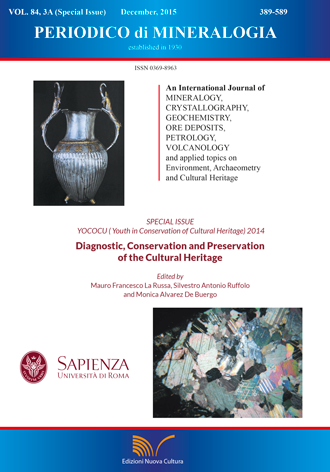Pigments and materials across Sardinia’s walls: contribution on the Tomba dei Pesci e delle Spighe in Cagliari
DOI:
https://doi.org/10.2451/2015PM0025Keywords:
Roman wall paintings, pigments, ATR-FTIR, SEM-EDS, XRD, egyptian blueAbstract
Sardinia is an ancient island where it is possible to find signs and symbols, decorative engraved and colored traces of men and history. In 1997 an ancient tomb in Cagliari has been discovered: it is located in the necropolis of Tuvixeddu, an old and spread necropolis dating from Punic to Roman times now located in the urban texture. The tomb, consisting of only one chamber, is dated by archaeologists a few centuries A.D. The name, Tomba dei Pesci e delle Spighe, is related to the painted decorations that were clearly visible on the walls and roof of the burial chamber, not so easily distinguishable anymore because of natural decay processes. Wall paintings appear severely damaged owing to the darkening of some areas, the detachments of others and a widespread presence of superficial concretions on the roof surfaces. This contribution aims to characterize pigments and the painting technique used in this burial chamber and compare them to the roman tradition. The site is confined, with evident problems of conservation because of the critical microclimatic conditions. High humidity and degradation are compromising the legibility of the decorative schemes. Samples of constituting materials and concretions have been collected and analyzed using x-rays diffraction (XRD) and IR spectroscopy (µFTIR-ATR). Preparatory layers supporting the pictorial have inorganic nature: diffractograms showed the presence of gypsum and calcite. IR spectroscopy (µFTIR) and scanning electron microscopy coupled with an energy dispersive system (SEM-EDS) were used to investigate the nature of pigments. Samples of blue, red and yellow pigments have been investigated. Egyptian blue, cinnabar and earth pigments have been detected. Proteinaceous materials have been identified as possible binders for the pigments.


